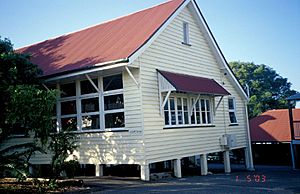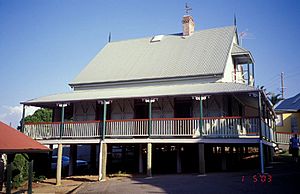Hemmant State School facts for kids
Quick facts for kids Hemmant State School |
|
|---|---|

1876 school building
|
|
| Location | 56 Hemmant–Tingalpa Road, Hemmant, City of Brisbane, Queensland, Australia |
| Design period | 1870s–1890s (late 19th century) |
| Built | 1876–1930s |
| Architect | Francis Drummond Greville Stanley |
| Official name: Hemmant State School and Dumbarton, Ashcroft House, Gibson House, Bulimba Creek School, Doughboy Creek Mixed School | |
| Type | state heritage (built) |
| Designated | 4 September 2003 |
| Reference no. | 602382 |
| Significant period | 1870s (historical) 1870s–1930s (fabric) 1876–ongoing (social) |
| Significant components | staffroom/s / teachers' room/s / teachers' retiring room/s, residential accommodation – housing, school/school room, play shed |
| Lua error in Module:Location_map at line 420: attempt to index field 'wikibase' (a nil value). | |
Hemmant State School is a special place in Hemmant, Australia, with a long history. It's listed on the Queensland Heritage Register because of its importance. The school was built between 1876 and the 1930s, with famous architect Francis Drummond Greville Stanley involved in its design. It was also known by earlier names like Bulimba Creek School. On its grounds, you'll find an old house called Dumbarton, which has its own interesting story. The original Hemmant State School closed in 2010. Since 2012, the site has been home to the Hemmant Flexible Learning Centre, a new school that helps students who need a different way to learn.
Contents
School History and Growth
Hemmant State School first opened its doors on May 9, 1864, as the Bulimba Creek School. It started as a "non-vested" school, meaning parents helped pay for the building, and the government provided the teacher. The first building was made of timber and shingles.
The area around the school was originally called Doughboy Creek. Settlers from England, Scotland, Holland, and Germany started farms there in the mid-1800s. They grew vegetables and fruit, which they sent to Brisbane.
Early Sugar Farming
In the 1860s, some farmers in Hemmant, like William Gibson, started growing sugar cane. They even built sugar mills. However, after a few years of bad weather and plant diseases, sugar farming moved to other parts of Queensland. Hemmant then went back to growing vegetables and dairy farming.
School Buildings and Changes
As the community grew, the school needed new buildings. In 1876, a new school building was constructed. It was designed by Francis Drummond Greville Stanley, who was the Colonial Architect at the time. In 1884, a large open playshed was added, which was a common design for schools back then.
Over the years, the school changed its name several times to avoid confusion with other schools. It was called Doughboy Creek Mixed School, then Doughboy Primary School, and finally Hemmant Primary School in 1876.
More improvements were made over time. In 1915, an open-air annexe was built, which was later enclosed with windows. A teachers' room was added in 1931. The school continued to expand with new classrooms and remodelling in the 1950s and 1960s.
The Story of Dumbarton House
In 2001, an old house called Dumbarton was moved to the Hemmant State School site. This house is important because it shows what homes looked like in the late 1800s when Hemmant was a farming community.
The land where Dumbarton originally stood was first owned by Friedrich Uhlmann in 1859. The house itself was likely built in the 1870s or early 1880s. Local stories say it was built by Friedrich Uhlmann for the Gibson family, who were early settlers and important in the area's history. The Gibson and Uhlmann families were connected through marriage.
Saving Dumbarton
In 2000, the house was going to be demolished to make way for a new road. But local residents, along with descendants of the Gibson and Uhlmann families, worked hard to save it. Because of their efforts, the house was moved to the school grounds in April 2001. The name "Dumbarton" was given to the house more recently, named after the Ashcroft family's original home in Scotland. Before that, it was known as the Gibson House or the Ashcroft House.
What the School Looks Like
Hemmant State School is located on a large piece of land. The older, historic buildings are on the western side of the property. These include the 1876 school building, the 1915 annexe, the 1931 teachers' room, the 1884 playshed, and Dumbarton House. They are all arranged around a paved play area.
The 1876 School Building
This is the oldest building and is closest to the main road. It's a timber building with a corrugated iron roof. It has been divided into two classrooms. You can see its old-fashioned weatherboard walls and hopper windows.
The 1915 Annexe
This building is north of the 1876 school. It's a taller timber building that has been changed and added to over the years. It has a corrugated iron roof and chamferboard walls. Inside, it has several rooms, including a large classroom.
The 1931 Teachers' Room
This is a smaller, low-set timber building next to the 1915 annexe. It has casement windows with awnings.
The 1884 Playshed
The playshed is an open timber structure with a corrugated iron roof. It's a simple, strong building that provided shelter for students during playtime. It even has hooks that might have been used for gym equipment!
Dumbarton House
Dumbarton is a single-story house with a unique look. It has a gabled roof and a verandah that goes all the way around the main part of the house. Some parts of the verandah have been enclosed. Inside, it has a central hallway with rooms leading off it.
Why Hemmant State School is Important
Hemmant State School and Dumbarton House are listed on the Queensland Heritage Register for several reasons:
- Showing Queensland's History: The school, established in 1864, is one of Queensland's oldest state schools that is still operating. It shows how communities grew around Brisbane, especially with farming and later industries.
- Rare and Special: It's uncommon to find such old school buildings still standing. The 1884 playshed is especially rare and well-preserved.
- Showing School Design: The different buildings at the school show how school architecture changed over time, reflecting new ideas about education. Dumbarton House also shows the style of homes from the late 1800s.
- Community Connection: The school has always been a very important place for the Hemmant community. It was a meeting place and a centre for many years. Dumbarton House also has a strong link to the community, as locals fought to save it from demolition.
- Important People: The school and Dumbarton House are connected to the Gibson and Uhlmann families, who were among the first settlers in the area. The Gibson family was also important in the early Queensland sugar industry.
Images for kids



